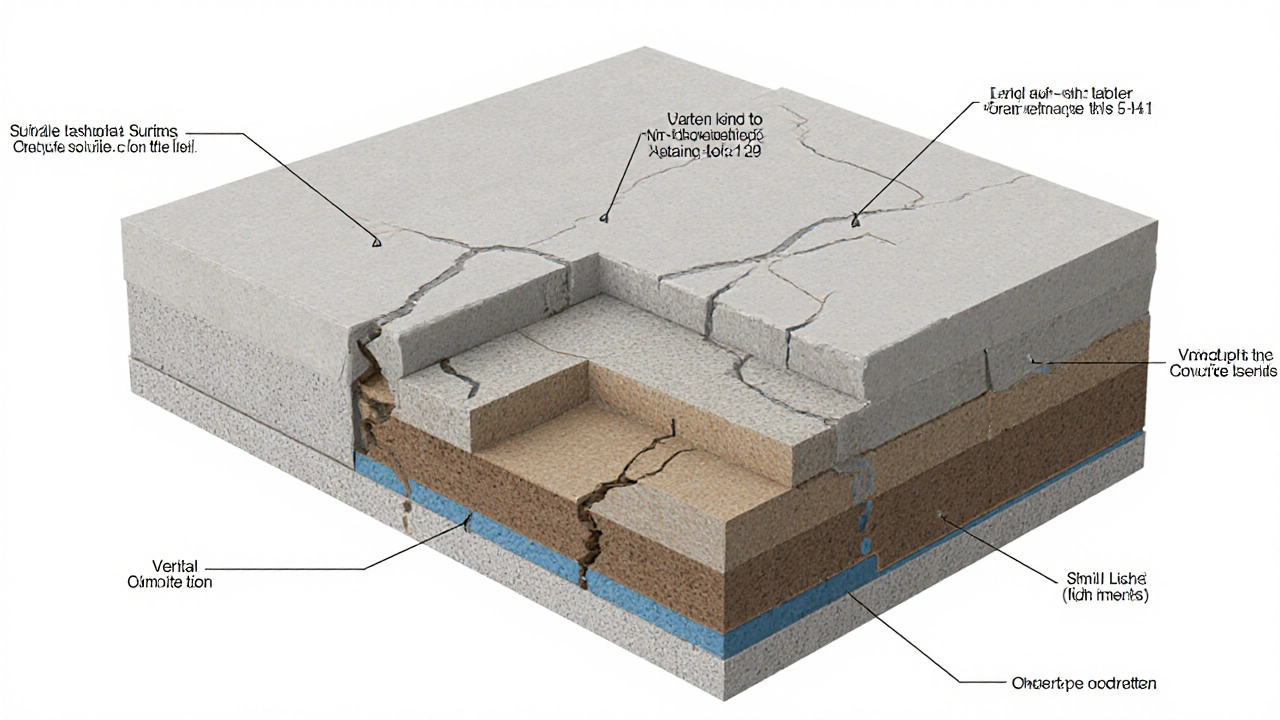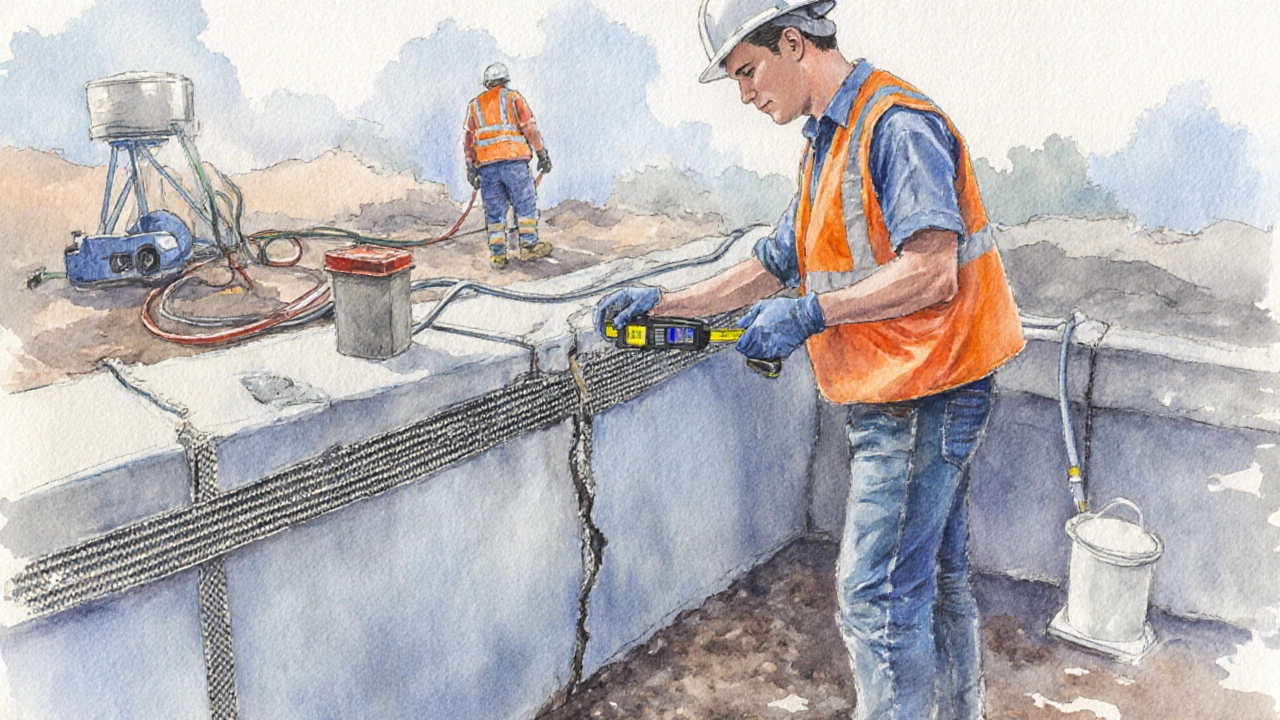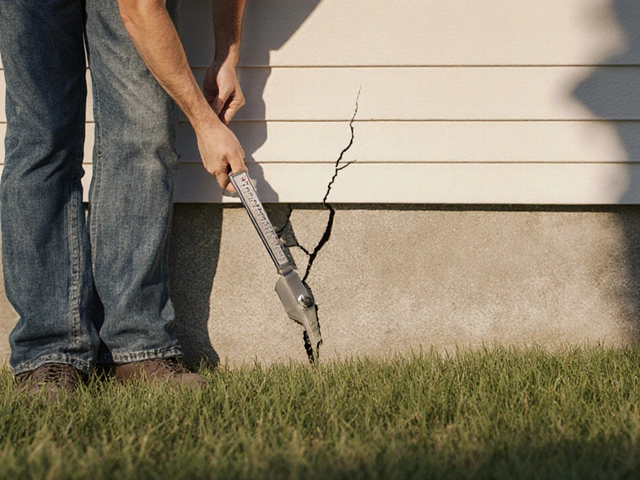Foundation Crack Size Checker
Enter the crack width and type to determine if it's acceptable and what action to take.
- Hair-line (surface) ≤0.3 mm
- Vertical non-structural ≤1 mm
- Diagonal or stair-step ≤2 mm
- Horizontal Any width - Requires immediate review
Key Takeaways
- Hair‑line cracks (≤0.3mm) are normal and usually don’t need fixing.
- Cracks wider than 1mm may signal settlement or structural stress and should be evaluated.
- Vertical or stair‑step cracks beyond 2mm often require professional repair.
- The NewZealand Building Code limits structural cracks to 0.5mm movement per year.
- Regular inspection, proper drainage, and control joints keep cracks within acceptable limits.
When you spot a crack in your home’s foundation, the first reaction is usually worry. Is the house going to collapse? Do I need an expensive repair right away? The truth is, not every crack is a red flag. Understanding what size crack is acceptable helps you decide whether to monitor, DIY fix, or call a specialist.
Foundation crack is a fissure that appears in a building's foundation, typically in concrete or masonry, indicating movement or stress. While some cracks are harmless, others can point to serious structural issues. Below we break down the types, the sizes that are considered normal, and the steps you can take to keep your foundation safe.
What Causes Foundation Cracks?
Before judging a crack by its width, know why it formed. The most common drivers are:
- Soil movement is the shifting, expanding, or shrinking of the ground beneath a foundation caused by moisture changes, temperature, or load.
- Concrete shrinkage is the natural reduction in volume as concrete cures and loses moisture.
- Improper installation of expansion joints is gaps built into a slab to allow controlled movement without cracking the surrounding material.
- Load stress from heavy equipment, nearby construction, or uneven weight distribution.
Types of Cracks and Their Typical Widths
Not all cracks are created equal. Classifying them helps you gauge seriousness.
| Crack Type | Max Acceptable Width | Common Cause | Repair Recommendation |
|---|---|---|---|
| Hair‑line (surface) crack | ≤0.3mm | Concrete curing, minor settlement | Monitor, seal if water infiltration |
| Vertical non‑structural crack | ≤1mm | Uniform soil movement, temperature change | Seal; professional check if widening |
| Diagonal or stair‑step crack | ≤2mm | Localized settlement, foundation shifting | Engineer assessment; epoxy injection if >1mm |
| Horizontal crack | Any width (requires immediate review) | Pressure from soil or water against wall | Full structural evaluation; likely pier installation |
Notice the jump in concern once a crack surpasses 1mm. While a 0.5mm vertical crack might simply be a sign of normal seasonal movement, a 2mm stair‑step crack often signals differential settlement that could worsen.
What the NZ Building Code Says About Crack Movement
The NewZealand Building Code is a set of regulations governing construction standards, including limits on structural movement (Clause B1). For residential foundations, it permits a total horizontal movement of up to 5mm and vertical movement of 6mm over a 10‑year period. Translating that to crack width, a rule of thumb is:
- Structural cracks should not exceed 0.5mm of movement per year - roughly 5mm over ten years.
- If a crack widens faster than this rate, it likely breaches the code’s limits.
Local councils often require a certified engineer’s report when a crack appears to violate these thresholds.

How to Inspect and Measure Cracks Accurately
Getting a reliable measurement is easier than you think. Follow these steps:
- Clean the crack with a soft brush to remove dust and debris.
- Place a crack gauge is a thin, calibrated metal or plastic strip with marked increments used to measure fissure widths (or a ruler with millimeter markings) directly into the opening.
- Read the width at three points: top, middle, bottom. Record the widest value.
- Take photos with a ruler for reference and note the date.
- Re‑measure every 3‑6 months to track any progression.
For cracks narrower than 0.3mm, a magnifying glass or smartphone macro mode helps confirm the size.
When Does a Crack Require Repair?
Use this decision tree to decide:
- If the crack is hair‑line and stable → No repair, just monitor.
- If the crack is vertical and ≤1mm but shows signs of water seepage → Seal with epoxy or polyurethane.
- If the crack is diagonal or stair‑step and >1mm → Call a structural engineer; consider epoxy injection or underpinning.
- If the crack is horizontal of any width → Immediate professional evaluation; likely a pressure issue.
Additional red flags include:
- Cracks that appear suddenly after heavy rain.
- Cracks that widen by more than 0.5mm within a month.
- Cracks accompanied by uneven floors, doors that stick, or windows that jam.
Common Repair Methods and Approximate Costs in NZ
Below is a quick cost snapshot for Auckland homeowners in 2025. Prices vary by contractor and site access.
| Method | Suitable For | Cost Range (NZD) | Time to Complete |
|---|---|---|---|
| Epoxy injection | Vertical or diagonal cracks 0.3‑2mm | 1,200-2,800 | 1-2 days |
| Polyurethane sealant | Hair‑line cracks, water infiltration | 300-700 | Same day |
| Carbon fiber reinforcement | Structural cracks >2mm | 3,500-6,000 | 2-4 days |
| Underpinning (pier installation) | Horizontal cracks, severe settlement | 8,000-15,000 | 1-2 weeks |
Choosing the right method hinges on the crack’s type, width, and underlying cause.
Preventing Future Cracks
Proactive steps can keep your foundation within the acceptable range:
- Maintain proper drainage: Ensure gutters direct water at least 3m away from the house.
- Control soil moisture: Avoid over‑watering garden beds near the foundation and consider installing a moisture barrier.
- Install or repair expansion joints: They allow the slab to move without cracking.
- Seasonally monitor: Check cracks after heavy rain or drying periods.
- Consider soil reinforcement: Lime or polymer soil stabilizers reduce swelling in expansive clays common around Auckland.
Quick Inspection Checklist
- Clean and measure any visible cracks.
- Record width, orientation, and location.
- Look for water stains, mold, or efflorescence.
- Test for movement by tapping the crack-listen for a hollow sound.
- Compare measurements with previous readings; note any growth.
- If any width exceeds 1mm (vertical) or 2mm (diagonal) or if it’s horizontal, arrange a professional assessment.

Frequently Asked Questions
What is a hair‑line crack and is it dangerous?
A hair‑line crack is a very thin fissure, usually ≤0.3mm wide. It’s a normal result of concrete curing or slight seasonal movement. As long as it stays unchanged and doesn’t let water in, it’s not a structural risk.
How fast can a foundation crack grow before I need to worry?
If a crack widens more than 0.5mm in a month, or more than 1mm over six months, it’s a sign of active movement. That rate exceeds the NZ Building Code’s allowable 0.5mm per year, so get a professional opinion promptly.
Can I seal a crack myself, or should I always hire a pro?
For hair‑line or small vertical cracks ≤1mm, a DIY epoxy or polyurethane sealant can work if you prepare the surface properly. For larger cracks, especially diagonal or horizontal ones, professional assessment and repair are recommended to avoid hidden structural damage.
Do expansion joints eliminate all foundation cracks?
Expansion joints allow controlled movement, which reduces random cracking, but they don’t stop all cracks. Soil movement, excessive loads, or poor construction can still produce cracks beyond the joints.
What is the typical cost to fix a 1mm vertical crack?
In Auckland, a professional epoxy injection for a 1mm vertical crack usually runs between NZD1,200 and NZD2,800, depending on access and length of the crack.
By measuring, monitoring, and understanding the context of each crack, you can decide whether a simple seal, a professional repair, or just a watch‑and‑wait approach is right. Remember, the goal isn’t to eliminate every line in the concrete-it’s to keep the movement within the limits that keep your home safe and sound.




Write a comment